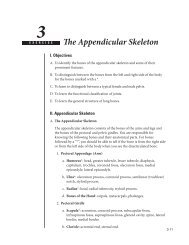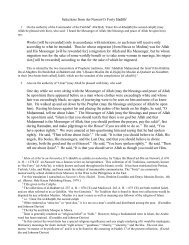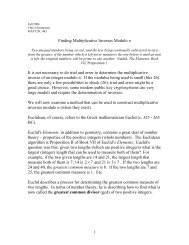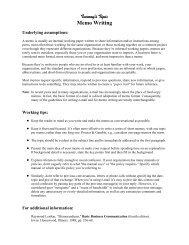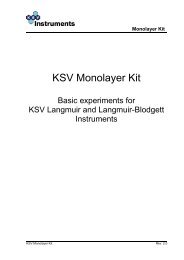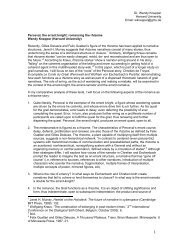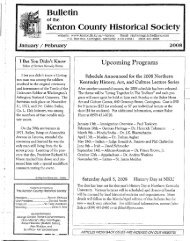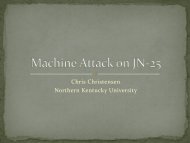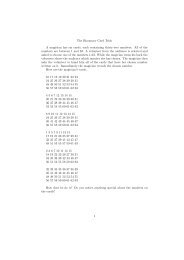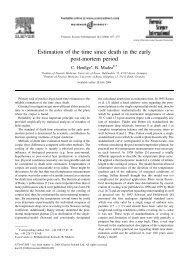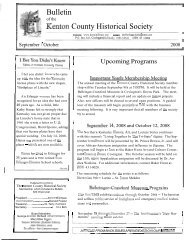SMS4 - Northern Kentucky University
SMS4 - Northern Kentucky University
SMS4 - Northern Kentucky University
You also want an ePaper? Increase the reach of your titles
YUMPU automatically turns print PDFs into web optimized ePapers that Google loves.
ALGEBRAIC CRYPTANALYSIS OF <strong>SMS4</strong><br />
JEREMY ERICKSON, TAYLOR UNIVERSITY<br />
Abstract. The <strong>SMS4</strong> block cipher is part of the Chinese WAPI wireless standard.<br />
It is a 32-round block cipher with 128-bit blocks and 128-bit keys. This<br />
paper explores algebraic attacks on <strong>SMS4</strong> using Gröbner basis attacks on equation<br />
systems over GF(2) and GF(2 8 ), as well as attacks using a SAT solver<br />
derived from the GF(2) model.<br />
1. Introduction<br />
Algebraic cryptanalysis is a relatively new field of cryptology. The basic idea is<br />
to model a cipher using a system of polynomial equations over a finite field. This<br />
approach has gained attention since Nicolas Courtois claimed that it could be used<br />
to attack AES, which has a simple algebraic structure [6]. This attack has also<br />
been attempted on other ciphers such as DES [5].<br />
The <strong>SMS4</strong> cipher was written by the Chinese government as part of their WAPI<br />
standard for wireless networks. The best currently known attacks on <strong>SMS4</strong> are the<br />
14-round rectangle attack and 16-round impossible differential attack discussed by<br />
Jiqiang Lu in [10]. However, as shown in [9], <strong>SMS4</strong> itself has a simple algebraic<br />
structure, similar to AES. Thus, I have attempted to attack it with algebraic attacks<br />
over GF(2). Wen Ji and Lei Hu have also attempted to attack <strong>SMS4</strong> with<br />
an algebraic attack over GF(2 8 ), as shown in [8], but their paper presents only<br />
a theoretical analysis, not an actual implementation. In this paper I present an<br />
attempt to attack <strong>SMS4</strong> with algebraic attacks over GF(2), including several potential<br />
alterations. I also present preliminary results of attacks based on GF(2 8 ) as<br />
in [8].<br />
Both types of attacks were implemented using the Magma computer algebra<br />
system ([3]), as well as using the MiniSAT boolean satisfiability solver in some<br />
cases.<br />
2. Structure of <strong>SMS4</strong><br />
<strong>SMS4</strong> is an unbalanced Feistel cipher with a block size of 128 bits and a key<br />
size of 128 bits. Each block is divided into four 32-bit blocks, referred to as<br />
“words”, which in turn consists of four 8-bit bytes. The official specification document<br />
for <strong>SMS4</strong> is available in Chinese at http://www.oscca.gov.cn/UpFile/<br />
Much of this work was done in conjunction with Chris Christensen and Amber Rogers of<br />
<strong>Northern</strong> <strong>Kentucky</strong> <strong>University</strong>, Brian Nixon of the <strong>University</strong> of Michigan, and Jintai Ding, Crystal<br />
Clough, John Baena, Daniel Cabarcas, and Zachary Vance of the <strong>University</strong> of Cincinnati, as part<br />
of an NSF-sponsored Research Experience for Undergraduates, funded by the Department of<br />
Defense.<br />
The Computational Algebra Group at the <strong>University</strong> of Sydney graciously provided Magma<br />
for this project.<br />
1
2 JEREMY ERICKSON, TAYLOR UNIVERSITY<br />
200621016423197990.pdf, and an English translation is provided at [7]. There are<br />
several fundamental components to the cipher.<br />
2.1. The <strong>SMS4</strong> S-Box. The official definition of the <strong>SMS4</strong> S-box is based on<br />
a table of values (See table 1.) However, as shown in [9], the S-box can also be<br />
0 1 2 3 4 5 6 7 8 9 a b c d e f<br />
0 d6 90 e9 fe cc e1 3d b7 16 b6 14 c2 28 fb 2c 05<br />
1 2b 67 9a 76 2a be 04 c3 aa 44 13 26 49 86 06 99<br />
2 9c 42 50 f4 91 ef 98 7a 33 54 0b 43 ed cf ac 62<br />
3 e4 b3 1c a9 c9 08 e8 95 80 df 94 fa 75 8f 3f a6<br />
4 47 07 a7 fc f3 73 17 ba 83 59 3c 19 e6 85 4f a8<br />
5 68 6b 81 b2 71 64 da 8b f8 eb 0f 4b 70 56 9d 35<br />
6 1e 24 0e 5e 63 58 d1 a2 25 22 7c 3b 01 21 78 87<br />
7 d4 00 46 57 9f d3 27 52 4c 36 02 e7 a0 c4 c8 9e<br />
8 ea bf 8a d2 40 c7 38 b5 a3 f7 f2 ce f9 61 15 a1<br />
9 e0 ae 5d a4 9b 34 1a 55 ad 93 32 30 f5 8c b1 e3<br />
a 1d f6 e2 2e 82 66 ca 60 c0 29 23 ab 0d 53 4e 6f<br />
b d5 db 37 45 de fd 8e 2f 03 ff 6a 72 6d 6c 5b 51<br />
c 8d 1b af 92 bb dd bc 7f 11 d9 5c 41 1f 10 5a d8<br />
d 0a c1 31 88 a5 cd 7b bd 2d 74 d0 12 b8 e5 b4 b0<br />
e 89 69 97 4a 0c 96 77 7e 65 b9 f1 09 c5 6e c6 84<br />
f 18 f0 7d ec 3a dc 4d 20 79 ee 5f 3e d7 cb 39 48<br />
Table 1. The <strong>SMS4</strong> S-box, with the first input nibble as the row<br />
index and the second as column index<br />
represented as an affine transformation over GF(2), followed by an inversion over<br />
GF(2 8 ), followed by another affine transformation over GF(2). The system is thus<br />
written as<br />
(1) s(x) = I(x · A + C) · A + C<br />
where I indicates inversion over GF(28 ) (with the inverse of 0 defined as 0) and the<br />
necessary field conversion. The values are given as<br />
⎡<br />
1 1 1 0 0 1 0<br />
⎢ 1 1 1 1 0 0 1<br />
⎢ 0 1 1 1 1 0 0<br />
⎢<br />
A = ⎢ 1 0 1 1 1 1 0<br />
⎢ 0 1 0 1 1 1 1<br />
⎢ 0 0 1 0 1 1 1<br />
⎣ 1 0 0 1 0 1 1<br />
1<br />
0<br />
1<br />
0<br />
0<br />
1<br />
1<br />
⎤<br />
⎥<br />
⎦<br />
1 1 0 0 1 0 1 1<br />
C = (1, 1, 0, 0, 1, 0, 1, 1)<br />
To convert from GF(2) to GF(2 8 ), we use the irreducible polynomial<br />
f(x) = x 8 + x 7 + x 6 + x 5 + x 4 + x 2 + 1<br />
and let the first term represent the constant term in a polynomial of degree 7, the<br />
second term represent the x coefficient, etc.
ALGEBRAIC CRYPTANALYSIS OF <strong>SMS4</strong> 3<br />
However, calculation shows that these results do not match the table provided<br />
in the <strong>SMS4</strong> specification without modification. If the input to and output from<br />
the S-box are each reversed, then the output is correct. Thus, this paper proposes<br />
the alternate model of the S-box<br />
(2) s(x) = A2 · I(A1 · x + C1) + C2<br />
with parameters<br />
⎡<br />
⎢<br />
A1 = ⎢<br />
⎣<br />
⎡<br />
⎢<br />
A2 = ⎢<br />
⎣<br />
1 0 1 0 0 1 1 1<br />
0 1 0 0 1 1 1 1<br />
1 0 0 1 1 1 1 0<br />
0 0 1 1 1 1 0 1<br />
0 1 1 1 1 0 1 0<br />
1 1 1 1 0 1 0 0<br />
1 1 1 0 1 0 0 1<br />
1 1 0 1 0 0 1 1<br />
1 1 0 0 1 0 1 1<br />
1 0 0 1 0 1 1 1<br />
0 0 1 0 1 1 1 1<br />
0 1 0 1 1 1 1 0<br />
1 0 1 1 1 1 0 0<br />
0 1 1 1 1 0 0 1<br />
1 1 1 1 0 0 1 0<br />
1 1 1 0 0 1 0 1<br />
C1 = (1, 1, 0, 0, 1, 0, 1, 1) T<br />
C2 = (1, 1, 0, 1, 0, 0, 1, 1) T<br />
Compared to the original model, this model uses right multiplication, reverses<br />
the columns of A for A1, reverses the rows of A for A2, uses C T for C1 and reverses<br />
C1 for C2. This achieves reversing the input and output, compared to equation 1.<br />
Calculations reveal that this model matches the table.<br />
When the S-box is used in <strong>SMS4</strong>, it is applied 4 times in parallel, to an entire<br />
word. Thus, X ∈ GF(2) 32 is split into (x1, x2, x3, x4) ∈ (GF(2) 8 ) 4 , and<br />
S(X) = s(x1)s(x2)s(x3)s(x4)<br />
2.2. The Linear Diffusion Transformation. <strong>SMS4</strong> uses two linear diffusion<br />
transformations, one for the round function and one for the key schedule. Here<br />
the notation ≪ represents circular left shifting. Each function operates on x ∈<br />
GF(2) 32 . For the round function, we use<br />
(3) L(x) = x ⊕ (x ≪ 2) ⊕ (x ≪ 10) ⊕ (x ≪ 18) ⊕ (x ≪ 24)<br />
For the key schedule, we use<br />
(4) L ′ (x) = x ⊕ (x ≪ 13) ⊕ (x ≪ 23)<br />
⎤<br />
⎥<br />
⎦<br />
⎤<br />
⎥<br />
⎦
4 JEREMY ERICKSON, TAYLOR UNIVERSITY<br />
2.3. The <strong>SMS4</strong> Key Schedule. We define a vector (Yi, Yi+1, Yi+2, Yi+3) ∈ (GF(2) 32 ) 4<br />
as the key schedule input to round i.<br />
Denote the input key as (K0, K1, K2, K3). Then<br />
Y0 = K0 ⊕ 0xa3b1bac6<br />
Y1 = K1 ⊕ 0x56aa3350<br />
Y2 = K2 ⊕ 0x677d9197<br />
Y3 = K3 ⊕ 0xb27022dc<br />
Also denote CKi = (cki,0, cki,1, cki,2, cki,3) ∈ (Z 8 2) 4 where cki,j = 28i + 7j<br />
mod 256, represented in binary.<br />
Then<br />
(5) RKi = Yi+4 = Yi ⊕ L ′ (S(Yi+1 ⊕ Yi+2 ⊕ Yi+3 ⊕ CKi))<br />
2.4. The <strong>SMS4</strong> Round Function. We define a vector (Xi, Xi+1, Xi+2, Xi+3) ∈<br />
(GF(2) 3 2) 4 as the input to round i, numbering the rounds from 0. Thus, (X0, X1, X2, X3)<br />
represents the plaintext. Then,<br />
(6) Xi+4 = Xi ⊕ L(S(Xi+1 ⊕ Xi+2 ⊕ Xi+3 ⊕ RKi))<br />
The output of the last four rounds is reversed (at the word level) to generate the<br />
ciphertext. Thus, the ciphertext is (X35, X34, X33, X32).<br />
3. Simplified <strong>SMS4</strong><br />
To provide for some basic exploration of the behavior of algebraic attacks over<br />
a larger number of rounds, as well as to provide a form of <strong>SMS4</strong> that can be<br />
worked out by hand, this paper proposes a simplified <strong>SMS4</strong> algorithm, which will<br />
be referred to from here as S-<strong>SMS4</strong>.<br />
The basic operations of S-<strong>SMS4</strong> are identical to full <strong>SMS4</strong>, except that all operations<br />
on 128-bit blocks become operations on 32-bit blocks, operations on 32-bit<br />
words become operations on 8-bit “words”, and operations on 8-bit bytes become<br />
operations on 4-bit nibbles.<br />
3.1. The S-<strong>SMS4</strong> S-box. The S-box of <strong>SMS4</strong> was designed from the description<br />
of the full <strong>SMS4</strong> S-box in [9]. The new S-box is designed to transform a 4-bit vector<br />
to another 4-bit vector, but otherwise follows equation 1 plus reversing input and<br />
output. Thus, a smaller cyclic matrix is the basic A with its bottom row as the<br />
row vector for C. Thus,<br />
A =<br />
⎡<br />
⎢<br />
⎣<br />
1 1 1 0<br />
0 1 1 1<br />
1 0 1 1<br />
1 1 0 1<br />
C = (1, 1, 0, 1)<br />
Accounting for the reversal and using the form of equation 2, however, we derive<br />
the following matrices in a similar manner:<br />
⎡<br />
0 1<br />
⎢<br />
A1 = ⎢ 1 1<br />
⎣ 1 1<br />
1<br />
1<br />
0<br />
1<br />
0<br />
1<br />
⎤<br />
⎥<br />
⎦<br />
1 0 1 1<br />
⎤<br />
⎥<br />
⎦
ALGEBRAIC CRYPTANALYSIS OF <strong>SMS4</strong> 5<br />
00 01 10 11<br />
00 1001 0001 1011 0010<br />
01 1111 0110 1000 1101<br />
10 0111 1100 0011 1110<br />
11 0100 0000 1010 0101<br />
Table 2. S-<strong>SMS4</strong> S-box, in the same form as table 1<br />
A2 =<br />
⎡<br />
⎢<br />
⎣<br />
1 1 0 1<br />
1 0 1 1<br />
0 1 1 1<br />
1 1 1 0<br />
C1 = (1, 1, 0, 1) T<br />
C2 = (1, 0, 1, 1) T<br />
The inversion step is similar to full <strong>SMS4</strong>, except that we use GF(2 4 ) with an<br />
irreducible polynomial of<br />
⎤<br />
⎥<br />
⎦<br />
f(x) = x 4 + x 3 + x 2 + x + 1<br />
This S-box can also be written as a table, see table 2.<br />
Because the S-<strong>SMS4</strong> S-box only accepts one byte as input, which is two nibbles,<br />
we split X ∈ (GF(2)) 32 into (x1, x2) ∈ (GF(2) 4 ) 2 and write:<br />
S(X) = s(x1)s(x2)<br />
These parameters were chosen in attempt to model the properties of the full<br />
<strong>SMS4</strong> S-box, providing a small field size over which inversion remains non-trivial.<br />
3.2. The S-<strong>SMS4</strong> Linear Diffusion Transformation. S-<strong>SMS4</strong>, like full <strong>SMS4</strong>,<br />
uses two linear diffusion transformations. Each function operates on x ∈ GF(2) 8 .<br />
For the round function,<br />
(7) L(x) = x ⊕ (x ≪ 2) ⊕ (x ≪ 6)<br />
For the key schedule,<br />
(8) L ′ (x) = x ⊕ (x ≪ 3) ⊕ (x ≪ 5)<br />
3.3. The S-<strong>SMS4</strong> Key Schedule. The key schedule for S-<strong>SMS4</strong> is analogous to<br />
full <strong>SMS4</strong>, except that we must use shorter initial keys and CK values. The initial<br />
keys are as follows:<br />
Y0 = K0 ⊕ 0xa3<br />
Y1 = K1 ⊕ 0xb1<br />
Y2 = K2 ⊕ 0xba<br />
Y3 = K3 ⊕ 0xc6<br />
Denote CKi = (cki,0, cki,1) ∈ (Z 4 2) 2 where cki,j = 11i + 3j mod 16, represented<br />
in binary. Then equation 5 holds.<br />
3.4. The S-<strong>SMS4</strong> Round Function. With the notations in this section, equation<br />
6 holds for simplified <strong>SMS4</strong>. We denote S-<strong>SMS4</strong> to have eight rounds, thus the<br />
ciphertext is (X11, X10, X9, X8).
6 JEREMY ERICKSON, TAYLOR UNIVERSITY<br />
4. Gröbner Basis and SAT Solver Attacks over GF(2)<br />
The primary attempt to attack <strong>SMS4</strong> in this paper is based on solving a system of<br />
equations over GF(2). The equations are divided into two groups, one representing<br />
the key schedule for the entire cipher, and one with a representation of the round<br />
function process for each plaintext/ciphertext pair. The Magma code is written<br />
in such a way that full and simplified <strong>SMS4</strong> can easily be compared by changing<br />
which predefined functions are loaded. (Some code in the Magma implementation<br />
was written by Brian Nixon.)<br />
4.1. Modelling the Inversion Step. The calculation of inversion in the S-box<br />
calculation can be done with several models. The simplest model is XY − 1 = 0<br />
for X, Y ∈ GF(2 8 ), which is only of degree 2. However, this model will not yield<br />
a solution for X = 0, and thus is not always sufficient to model the cipher. An<br />
alternative model is Y 2 X − Y = 0, which is still degree 2 when represented over<br />
GF(2) due to the property that x 2 = x, x ∈ GF(2). However, in this case, an<br />
extraneous solution Y = 0 is present for any input X, even when X is nonzero.<br />
Thus, the equation X 2 Y − X = 0 must be added to the system to yield a correct<br />
solution. For this reason, most previous attacks (c.f.e. [8]) use XY − 1 = 0 as the<br />
model for the cipher.<br />
To model the inversion over GF(2), we simply represent the coefficients on the<br />
polynomials for X and Y as variables in GF(2), perform the necessary operations,<br />
and mod by the appropriate irreducible polynomial. This was done using Magma<br />
for this project.<br />
The question with the simplified XY −1 = 0 model is how frequently it provides<br />
a correct result. One of 256 inputs (for <strong>SMS4</strong>) or 16 inputs (for S-<strong>SMS4</strong>) will<br />
require the inversion of zero. The round function for each round calls S(x) once,<br />
and thus s(x) four times for <strong>SMS4</strong> and two times for S-<strong>SMS4</strong>. The same numbers<br />
occur for the key schedule, so a round of <strong>SMS4</strong> will use inversion eight times and a<br />
round of S-<strong>SMS4</strong> will use inversion four times. The simplest probability model is<br />
to assume that all inputs to the S-boxes are independent and random. Denote the<br />
number of rounds as r. Thus, for <strong>SMS4</strong>:<br />
(9) Pzinv = 1 −<br />
and for S-<strong>SMS4</strong>:<br />
(10) Pzinv = 1 −<br />
� �8r 255<br />
256<br />
� �4r 15<br />
16<br />
In particular, for the full 32 rounds of <strong>SMS4</strong>, Pzinv = 1 − � �<br />
255 256 1<br />
256 ≈ 1 − e or<br />
63.28%, and for the full 8 rounds of S-<strong>SMS4</strong>, Pzinv = 1 − � �<br />
15 32<br />
16 ≈ 87.32% To test<br />
this model, we can also examine the expected number of zeros, which is simply 8r<br />
256<br />
for full <strong>SMS4</strong> and 4r<br />
16<br />
for S-<strong>SMS4</strong>.<br />
To verify these numbers, I used Magma to perform 10,000 random encryptions<br />
(random key and plaintext) for each multiple of 4 rounds, recording the number of<br />
zeros encountered at inversion and the number of encryption processes which used<br />
one or more zeros. The results are in table 3.<br />
We can see that the model closely matches the data. Thus, <strong>SMS4</strong> does behave<br />
like a random system, and we are justified in making our zero inversion predictions
ALGEBRAIC CRYPTANALYSIS OF <strong>SMS4</strong> 7<br />
<strong>SMS4</strong> S-<strong>SMS4</strong><br />
Pzinv # Zeros Pzinv # Zeros<br />
r Model Test Model Test Model Test Model Test<br />
4 11.77% 11.82% 0.1250 0.1248 64.39% 64.08% 1.0000 0.9962<br />
8 22.16% 21.58% 0.2500 0.2426 87.32% 87.00% 2.0000 1.9819<br />
12 31.32% 31.57% 0.3750 0.3798 95.49% 95.40% 3.0000 3.0105<br />
16 39.41% 39.16% 0.5000 0.4973 98.39% 98.37% 4.0000 4.0079<br />
20 46.54% 46.24% 0.6250 0.6213 99.43% 99.39% 5.0000 5.0092<br />
24 52.83% 53.21% 0.7500 0.7641 99.80% 99.81% 6.0000 5.9828<br />
28 58.38% 58.38% 0.8750 0.8863 99.93% 99.96% 7.0000 7.0271<br />
32 63.28% 63.25% 1.0000 0.9952 99.97% 99.98% 8.0000 8.0152<br />
Table 3. Model vs. Tests for Zero Inversion Frequency<br />
based on that assumption. In the case of breaking the full cipher, a zero inversion<br />
probability of 63.28% is low enough that either model would be reasonable, although<br />
a method that can handle zero inversions would be better if as fast.<br />
4.2. Modelling the Key Schedule. The key schedule is modelled separately from<br />
the rounds, because it only needs to be modelled once for any key to be broken,<br />
even if there is more than one plaintext/ciphertext pair. The following system of<br />
equations is used for each round r (indexed starting from 0) and byte (full)/nibble<br />
(simplified) index i (also indexed from 0). The model of the S-box inversion is<br />
excluded, as the system was tested using several representations. The real system<br />
has a set of equations indicating that ZKr,i and W Kr,i correspond to inverses in<br />
GF(2 8 ) or GF(2 4 ).<br />
A single subscript (e.g. BKr) indicates a word in GF(2) 32 or GF(2) 8 , and a<br />
double subscript (e.g. BKr,i) indicates a byte or nibble within the word.<br />
BKr = Yr+1 ⊕ Yr+2 ⊕ Yr+3 ⊕ CKr<br />
ZKr,i = A1 · BKr,i ⊕ C1<br />
DKr,i = A2 · W Kr,i ⊕ C2<br />
EKr = L ′ (DKr)<br />
Yr+4 = Yr + EKr<br />
When this system of equations is actually implemented in Magma, each variable<br />
in GF(2) (with the exception of W K variables) has its own equation. Vectors are<br />
used here for simplicity of explanation.<br />
4.3. Modelling the Round Function. The model for the round function is similar<br />
to the model of the key schedule. However, there is now a separate equation for<br />
each plaintext/ciphertext pair p. Thus, in this case, a double subscript indicates a<br />
word and a triple subscript indicates a nibble or byte. As in the case of the key<br />
schedule, the model also has a set of equations indicating that Zp,r,i and Wp,r,i<br />
correspond to inverses in the appropriate extension field.<br />
Bp,r = Xp,r+1 ⊕ Xp,r+2 ⊕ Xp,r+3 ⊕ Yr+4<br />
Zp,r,i = A1 · Bp,r,i ⊕ C1
8 JEREMY ERICKSON, TAYLOR UNIVERSITY<br />
Dp,r,i = A2 · Wp,r,i ⊕ C2<br />
Ep,r = L(Dp,r)<br />
Xp,r+4 = Xp,r + Ep,r<br />
As with the key schedule, when this system is actually implemented in Magma,<br />
each variable in GF(2) (with the exception of W variables) has its own equation.<br />
4.4. SAT Solver Attacks. In addition to Gröbner Basis attacks, some attacks<br />
over GF(2) were also attempted using MiniSAT. To convert the polynomials generated<br />
by Magma into the proper input form, Amber Rogers and I wrote a Perl<br />
script using the method of [2]. Our conversion system did not attempt to reorder<br />
or rewrite the equations to change the random seed, and we used a cutting size of 6<br />
as the paper suggested. The script allowed us to convert our equations to MiniSAT<br />
format, run the MiniSAT solver, and verify that the solution contained the correct<br />
key.<br />
5. Results of GF(2)-Based Attacks<br />
These attacks were tested on an Intel R○Core TM 2 Quad CPU running at 2.40<br />
GHz. The system had 16 GB of RAM and was running 64-bit Ubuntu 8.04.1,<br />
Magma version 2.14-15 and MiniSAT version 2.0.<br />
5.1. Field Equations. The field equations over GF(2) are of the form x 2 = x and<br />
hold ∀x ∈ GF(2). These equations allow the degree of a polynomial to be lowered<br />
if it contains any power of a variable, as by induction this property extends to<br />
x n = x, ∀n ∈ N. Thus, when the equation system was implemented in Magma, I<br />
included the field equation for each of the variables as part or the system. However,<br />
with the field equations included, Magma ran out of memory rather than obtaining a<br />
solution, but without them it was able to find the solution. This result is surprising,<br />
as the field equations should only be able to help.<br />
5.2. Magma vs. SAT solver. For small numbers of rounds, I tested Magma and<br />
MiniSAT both with the same systems of equations. The variance in solution time<br />
could be quite high for MiniSAT, so table 4 contains typical measurements for the<br />
two systems, both with <strong>SMS4</strong> and S-<strong>SMS4</strong>. For each test, two plaintext/ciphertext<br />
pairs were used.<br />
Magma MiniSAT<br />
Rounds Time (s) Mem (MB) Time (s) Mem (MB)<br />
<strong>SMS4</strong><br />
4 321.500 415.98 235.575 70.74<br />
5 940.720 854.61 >6000 -<br />
S-<strong>SMS4</strong><br />
4 7.860 28.07 0.032002 16.28<br />
5 20.420 59.27 0.100006 17.07<br />
6 1188.470 1075.45 0.364022 18.36<br />
7 71233.620 11733.60 6.044380 24.33<br />
Table 4. Typical test results
ALGEBRAIC CRYPTANALYSIS OF <strong>SMS4</strong> 9<br />
The results for S-<strong>SMS4</strong> seemed to indicate that the SAT solver could provide<br />
a more efficient solution, as is the case with only 4 rounds of <strong>SMS4</strong>. However, as<br />
verified in several tests, the SAT solver did not finish within 100 minutes with 5<br />
rounds of <strong>SMS4</strong>. Thus, Magma holds more promise for real attacks on <strong>SMS4</strong>.<br />
5.3. Varied Number of Plaintext/Ciphertext Pairs. One test I ran varied<br />
the number of plaintext/ciphertext pairs. The X 2 Y − X = 0, Y 2 X − Y = 0<br />
representation of the inversion was used. Results are in table 5. In the cases of 6<br />
and 7 rounds with only 1 pair, Magma ran out of memory for both cipher types.<br />
All other missing cases indicate that either Magma did run out of memory or the<br />
solution required more than 2 hours to complete. (The solver was killed after two<br />
hours.) It is possible that some of these missing cases would run out of memory if<br />
run to completion.<br />
We can see from the data for 5 and 6 rounds that the optimal number of plaintext/ciphertext<br />
pairs should be two. Furthermore, as shown in figure 1, the time<br />
complexity appears quadratic, while the memory complexity appears approximately<br />
linear.<br />
Figure 1. Time and memory complexity with varying pairs (full <strong>SMS4</strong>)<br />
5.4. Elminating the Key Schedule. The previous section demonstrated that<br />
adding more redundant equations to solve for the same key may not result in a<br />
faster solution. The added variables increased the complexity of the system, which<br />
likely accounts for the slow down. From this observation, another simplificiation of<br />
the cipher that may be attempted is to ignore the key schedule rather than include<br />
it. In the case of one plaintext-ciphertext pair, this yields a unique solution only<br />
in the case of four rounds. Even in the case of five rounds, numerous solutions<br />
are typically returned. However, with more than one plaintext-ciphertext pair, the<br />
results are usually either unique or contain a small number of solutions. (The actual<br />
key can be obtained from the first four broken round keys by using a process similar<br />
to <strong>SMS4</strong> decryption. Thus, modelling the key schedule is not actually necessary to<br />
determine the key.)<br />
Test results for both <strong>SMS4</strong> and S-<strong>SMS4</strong> are included in table 6. The data which<br />
includes the key schedule is the same as in the section comparing numbers of sets,<br />
and it is included for comparison. For most cases, removing the key schedule seems<br />
to provide a significant improvement in solution time. However, the case of 6
10 JEREMY ERICKSON, TAYLOR UNIVERSITY<br />
<strong>SMS4</strong> S-<strong>SMS4</strong><br />
Rounds PT/CT Pairs Time (s) Mem (MB) Time (s) Mem (MB)<br />
4 1 187.120 230.06 1.510 12.09<br />
2 325.910 467.04 3.009 19.16<br />
3 612.629 640.23 5.299 20.81<br />
4 1011.000 807.10 12.050 28.07<br />
5 1536.049 1286.81 18.519 39.14<br />
6 2204.170 1295.34 18.050 37.65<br />
7 3032.769 1652.99 25.170 76.85<br />
8 4043.800 1960.68 34.179 83.84<br />
9 5251.460 2306.81 45.079 131.16<br />
5 1 2602.820 14457.93 171.680 225.17<br />
2 926.129 860.56 8.259 20.59<br />
3 1768.740 1408.27 12.359 40.31<br />
4 2920.429 1509.54 20.870 59.03<br />
5 4500.359 1929.46 32.859 78.38<br />
6 - - 48.840 94.50<br />
7 - - 69.459 111.22<br />
8 - - 95.439 193.74<br />
9 - - 127.620 210.05<br />
6 1 - - - -<br />
2 2222.860 12344.91 325.750 545.61<br />
3 - - 622.990 734.40<br />
4 - - 1194.339 1106.62<br />
5 - - 2158.129 1327.62<br />
6 - - 3703.400 1909.23<br />
7 - - 6058.989 2572.89<br />
8 - - - -<br />
9 - - - -<br />
7 1 - - - -<br />
2 - - 6082.100 5503.66<br />
3 - - 6968.439 3395.06<br />
Table 5. <strong>SMS4</strong> and S-<strong>SMS4</strong> tested with Magma<br />
rounds (<strong>SMS4</strong>) seems to indicate that for that many rounds, the presence of the<br />
key schedule is necessary. This is not surprising, because with only four rounds,<br />
a relatively simple algebraic process can determine the key, due to the fact that<br />
all the values of Xi are known. Thus, the key schedule provides unnecessary extra<br />
information in the case of four rounds, and seemingly for five as well according to<br />
the data. In the case of S-<strong>SMS4</strong>, removing the key schedule only seems to help,<br />
probably due to its simpler algebraic structure as compared to the full cipher.<br />
5.5. Varied S-box Representations. I also tested with both representations of<br />
the S-box described above, as well as the case of the incomplete model X 2 Y −X = 0<br />
for comparison. Surprisingly, Magma ran out of memory for any representation<br />
other than the fully correct model, even in cases where the system was correct as
ALGEBRAIC CRYPTANALYSIS OF <strong>SMS4</strong> 11<br />
With Key Schedule No Key Schedule<br />
Rounds Pairs Time (s) Mem (MB) Time (s) Mem (MB)<br />
<strong>SMS4</strong><br />
4 2 325.910 467.04 26.359 108.95<br />
3 612.629 640.23 122.810 197.23<br />
4 1011.000 807.10 250.110 317.42<br />
5 1536.049 1286.81 479.250 617.46<br />
6 2204.170 1295.34 637.779 902.41<br />
7 3032.769 1652.99 1248.789 1212.59<br />
8 4043.800 1960.68 1499.650 1766.69<br />
9 5251.460 2306.81 2130.889 1368.74<br />
5 2 926.129 860.56 104.579 191.09<br />
3 1768.740 1408.27 316.129 468.84<br />
4 2920.429 1509.54 730.720 886.63<br />
5 4500.359 1929.46 1383.690 1266.73<br />
6 2 2222.860 12344.91 >7200 -<br />
S-<strong>SMS4</strong><br />
4 2 3.009 19.16 0.770 9.36<br />
3 5.299 20.81 1.459 12.76<br />
4 12.050 28.07 2.700 19.61<br />
5 18.519 39.14 4.639 22.44<br />
6 18.050 37.65 7.769 27.19<br />
7 25.170 76.85 12.089 36.93<br />
8 34.179 83.84 18.170 37.40<br />
9 45.079 131.16 25.339 71.13<br />
5 2 8.259 20.59 1.480 11.64<br />
3 12.359 40.31 3.529 16.57<br />
4 20.870 59.03 7.669 28.48<br />
5 32.859 78.38 13.929 45.65<br />
6 48.840 94.50 23.629 65.23<br />
7 69.459 111.22 36.649 71.41<br />
8 95.439 193.74 53.859 88.65<br />
9 127.620 210.05 77.370 160.93<br />
6 2 325.750 545.61 61.679 102.76<br />
3 622.990 734.40 127.390 176.76<br />
4 1194.339 1106.62 303.939 277.16<br />
5 2158.129 1328.62 723.850 445.93<br />
6 3703.400 1909.23 1452.930 843.32<br />
7 6058.989 2572.89 2619.429 1241.78<br />
7 2 6082.100 5503.66 1968.109 2282.16<br />
3 6968.439 3395.06 2634.119 958.47<br />
Table 6. Comparison to determine importance of key schedule<br />
verified by using the SAT solver instead. However, I did discover that in the case<br />
of four rounds with no key schedule, Magma did seem to work. In the case of 5
12 JEREMY ERICKSON, TAYLOR UNIVERSITY<br />
rounds, Magma runs to completion, but finds an empty variety, even though the<br />
SAT solver finds the correct key given the same set of equations.<br />
In the case of 4 rounds, using only X 2 Y − X = 0 for two plaintext/ciphertext<br />
pairs finishes in 22.900 s, whereas the standard representation requires 26.359 seconds.<br />
The XY − 1 = 0 representation runs in 22.950 s. Thus, the three representations<br />
seem almost equivalent. With only one plaintext/ciphertext pair,<br />
X 2 Y −X = 0, Y 2 X −Y = 0 runs in 4.000 s, while XY −1 = 0 runs in 3.630. These<br />
particular cases seem to indicate that even if the system did work as expected, the<br />
various S-box representations are mostly equivalent. Thus, only a small speedup<br />
can be obtained from XY − 1 = 0.<br />
6. GF(2 8 ) Attacks<br />
Using the method of [8], I wrote a Magma program to test the attack over GF(2 8 ).<br />
As discussed in [4], [11], and [1], XSL would not be expected to outperform a good<br />
Gröbner basis basis algorithm such as F4. Thus, Magma’s builtin F4 algorithm<br />
is used, rather than XSL. The equation system from [8] is used almost unaltered.<br />
However, there is an off-by-one error in their indexing of all X variables (resulting<br />
in the use of X−1 in the first round), and their model of the S-box is taken from<br />
[9] unaltered and does not take reversal into account. Thus, I increased the index<br />
of the X variables by one and utilized my corrected S-box model from section 2.1.<br />
This resulted in a system that produced correct results for 4 rounds, with runtimes<br />
consistently between 240 and 250 seconds, and using 283.53MB of RAM each time.<br />
Because this attack used only one plaintext/ciphertext pair, and it has a time<br />
measurement between the values for one and two rounds with the similar GF(2)<br />
attack (187.120 and 325.910 s, respectively), with similar results for memory, the<br />
GF(2 8 ) attack seems to have similar efficiency to the GF(2) attack, at least for four<br />
rounds. However, upon testing with more rounds on my system, Magma runs out<br />
of memory, so I was unable to determine how the behavior varies with more rounds.<br />
Thus, I was not able to determine whether the speed claims in [8] are consistent<br />
with experiments, other than that their prediction of 2 59 for the attack on four<br />
rounds is far too high. Further experimentation on a system with more available<br />
RAM is necessary.<br />
7. Further Work<br />
There are many possible improvements which I have not had time to explore. One<br />
area of exploration is mixing guessing with finding results algebraically. Either some<br />
of the key bits or some of the intermediate variables could be guessed. Experiments<br />
could be performed to determine the optimal number and choice of variables to<br />
guess to speed up the attack.<br />
Another possible improvement would be to find the Gröbner basis of some part<br />
of the cipher, such as the S-box, and use that in place of the direct representation.<br />
Thus, some of the work of the solver would be done ahead of time. When we<br />
performed this experiment on DES during the summer REU portion of my research,<br />
it actually caused a slowdown. However, experimenting with the effects of different<br />
portions of precomputation on different portions of the cipher could yield fruitful<br />
results.<br />
The ordering of the variables is significant in the case of the F4 algorithm used<br />
by Magma. Thus, experiments could be performed with a different ordering of
ALGEBRAIC CRYPTANALYSIS OF <strong>SMS4</strong> 13<br />
the variables, either when the system is written, or by using a different ordering<br />
algorithm (e.g. lexicographical, graded lexicographical, etc.) when running the<br />
algorithm.<br />
Further work on the GF(2 8 ) attack is necessary. Experiments should be peformed<br />
with sufficient RAM to test several numbers of rounds, so that the increase<br />
in complexity can be measured. Many of the same alterations made with the GF(2)<br />
model, such as changing the S-box representation and varying the number of plaintext/ciphertext<br />
pairs could also be tested with the GF(2 8 ) model, to verify whether<br />
they have the same effect.<br />
Finally, several of the unexpected results using Magma could be further explored.<br />
For example, why does adding the field equations slow down Magma and increase<br />
the memory usage, rather than leading to a more efficient solution? Also, why does<br />
the solver fail to find the correct solution with varied S-box representations even<br />
though the SAT solver reveals the system of equations is correct? Perhaps the same<br />
equations could be tested using another solver using F4 to see if the same results<br />
occur, to determine whether the issue is an implementation problem with Magma<br />
or some property of the algorithm.<br />
References<br />
[1] Gwénolé Ars, Jean-Charles Faugère, Hideki Imai, Mitsuru Kawazoe, and Makoto Sugita.<br />
Comparison between xl and gröbner basis algorithms. In Pil Joong Lee, editor, ASIACRYPT,<br />
volume 3329 of Lecture Notes in Computer Science, pages 354–371. Springer, 2004.<br />
[2] Gregory V. Bard, Nicolas T. Courtois, and Chris Jefferson. Efficient methods for conversion<br />
and solution of sparse systems of low-degree multivariate polynomials over gf(2) via satsolvers.<br />
Cryptology ePrint Archive, Report 2007/024, 2007. http://eprint.iacr.org/.<br />
[3] Wieb Bosma, John J. Cannon, and Catherine Playoust. The magma algebra system i: The<br />
user language. J. Symb. Comput., 24(3/4):235–265, 1997.<br />
[4] Carlos Cid and Gaëtan Leurent. An analysis of the xsl algorithm. In Bimal K. Roy, editor,<br />
ASIACRYPT, volume 3788 of Lecture Notes in Computer Science, pages 333–352. Springer,<br />
2005.<br />
[5] Nicolas Courtois and Gregory V. Bard. Algebraic cryptanalysis of the data encryption standard.<br />
In Steven D. Galbraith, editor, IMA Int. Conf., volume 4887 of Lecture Notes in<br />
Computer Science, pages 152–169. Springer, 2007.<br />
[6] Nicolas Courtois and Josef Pieprzyk. Cryptanalysis of block ciphers with overdefined systems<br />
of equations. In Yulian Zheng, editor, ASIACRYPT, volume 2501 of Lecture Notes in<br />
Computer Science, pages 267–287. Springer, 2002.<br />
[7] Whitfield Diffie and George Ledin (translators). Sms4 encryption algorithm for wireless networks.<br />
Cryptology ePrint Archive, Report 2008/329, 2008. http://eprint.iacr.org/.<br />
[8] Wen Ji and Lei Hu. New description of sms4 by an embedding over gf(2 8 ). In K. Srinathan,<br />
C. Pandu Rangan, and Moti Yung, editors, INDOCRYPT, volume 4859 of Lecture Notes in<br />
Computer Science, pages 238–251. Springer, 2007.<br />
[9] Fen Liu, Wen Ji, Lei Hu, Jintai Ding, Shuwang Lv, Andrei Pyshkin, and Ralf-Philipp Weinmann.<br />
Analysis of the sms4 block cipher. In Josef Pieprzyk, Hossein Ghodosi, and Ed Dawson,<br />
editors, ACISP, volume 4586 of Lecture Notes in Computer Science, pages 158–170. Springer,<br />
2007.<br />
[10] Jiqiang Lu. Attacking reduced-round versions of the sms4 block cipher in the chinese wapi<br />
standard. In Sihan Qing, Hideki Imai, and Guilin Wang, editors, ICICS, volume 4861 of<br />
Lecture Notes in Computer Science, pages 306–318. Springer, 2007.<br />
[11] Bo-Yin Yang, Jiun-Ming Chen, and Nicolas Courtois. On asymptotic security estimates in<br />
xl and gröbner bases-related algebraic cryptanalysis. In Javier Lopez, Sihan Qing, and Eiji<br />
Okamoto, editors, ICICS, volume 3269 of Lecture Notes in Computer Science, pages 401–413.<br />
Springer, 2004.



